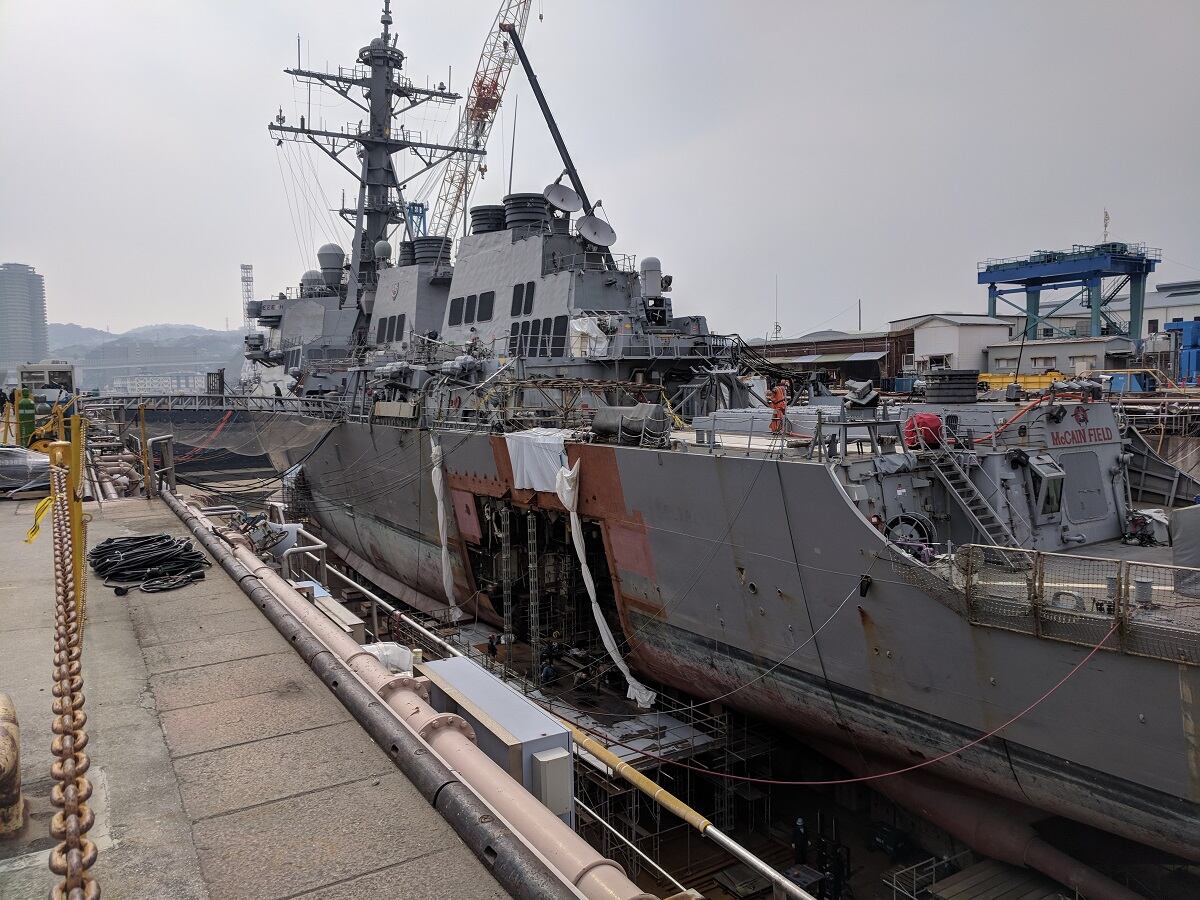WASHINGTON — A Japan-based destroyer sidelined by a deadly collision in 2017 will not return to the fleet because of a new issue that arose in testing after it returned to the water from dry dock, Naval Sea Systems Command confirmed to Defense News.
The port shaft on the U.S. Navy destroyer John S. McCain — which runs through the hull and turns one of the ship’s twin screws — is out of alignment, something workers discovered when waterborne tests caused high vibrations, according to sources who spoke to Defense News.
“During the testing, Navy maintenance subject matter experts determined the ship’s port shaft was misaligned likely due to the August 2017 collision,” NAVSEA spokeswoman Colleen O’Rourke said in a statement. “Shaft alignment adjustments are in process and scheduled to complete in October 2019. This ship is scheduled to complete her industrial availability in November 2019.”
The fleet hoped to get McCain back as early as this spring, according to an interview earlier this year with Vice Adm. Phil Sawyer, the commander of U.S. 7th Fleet.
The repair to the McCain had been relatively straightforward compared to its sister ship Fitzgerald, which had significant alignment issues in its superstructure, thus degrading the AN/SPY-1 radar’s performance. The plan was to essentially cut away the damaged part and rebuild the section whole cloth.
The challenge was that the supply system for destroyers isn’t set up for rebuilding discrete sections of the ship, so working through those issues took time. Furthermore, there were lingering issues with McCain that the Navy wanted to fix while the ship was out of the water, Sawyer told Defense News in 2017.
A misaligned shaft can mean either the bearings that support and turn the shaft are out of whack (not good, but fixable), or that the shaft is warped or the main reduction gear is out of alignment (very bad), according to a former naval engineer, who spoke on condition of anonymity. It’s unclear which it is, but the fact that the work is slated to be done this year indicates the problem lies with the bearings.
The Fitzgerald ― the more seriously damaged of the two destroyers ― is also back in the water and on track to deliver next summer, according to Naval Sea Systems Command.
“The ship continues to undergo outfitting and testing and is on track to deliver in summer of 2020,” O’Rourke said.
RELATED

Post-collisions reforms
While the engineers piece the ships back together, Pacific Fleet has undergone extensive repairs. In the wake of the collisions, the Navy instituted much tighter controls over how its Japan-based ships are employed.
After the accidents, it emerged that the Navy was working around its own standards to keep ships underway and employed on missions, even if the ship was not fully trained and certified the way such vessels are required prior to deployment from the United States.
That era is over, according to Sawyer, who spoke to Defense News in March.
“It’s incumbent upon me that before I put my ships out on operations, that they are fully trained and certified to do that mission,” Sawyer said. “And my entire team knows that.
“So, if a ship was being tasked to do something and it wasn’t fully trained and certified, it just wouldn’t even get that far. Because at every level of my staff, including the [combined task forces] out here, they know that there’s not even going to be a conversation about assigning someone who isn’t trained and certified. It’s a red line.”
Sawyer and his staff have developed and implemented a system that moves away from a rolling certifications model — where ships earned their certifications in, for example, navigation, combat scenarios, damage control and engineering drills as they expired — and moves it closer to the system followed by ships based in the United States.
That’s a system to which 7th Fleet is committed, he said, even in the face of heavy demand for ships.
“There is always more demand than I have supply,” Sawyer said. “And that has been the case since I first started in the Navy, and it’s always going to be the case.
“I only supply that which I can supply. And said another way: We’re not going to put them out there to do operations unless they are trained and certified. It’s critical to our force-generation model, and I’m allegiant to making sure that remains the standard.”
David B. Larter was the naval warfare reporter for Defense News.








